Steam generator for a shower cabin: types, principle of operation + recommendations for selection and installation
There are many people who want to warm up in a home bathhouse or sauna. However, it is not always possible to arrange such a steam room in a city apartment.An alternative solution is a steam generator for a shower cabin, which allows you to turn the shower box into a kind of Turkish hammam.
There are a lot of models with various additional features offered in stores, but not all of them are worth the money. Therefore, you should pay special attention to the choice of equipment so that the purchase does not disappoint later.
We will tell you how a steam generator works, outline the features of different types of such equipment, and provide tips on choosing and installing a steam generator.
The content of the article:
How does a steam generator work?
A household steam generator is a simple electrical appliance that converts water into hot steam by heating.
On one side of this device there is a connector for connecting water supply, and on the other there is an outlet for water vapor.

A steam generator for a shower cabin consists of the following parts:
- block and control panel;
- waterproof case with heating chamber;
- temperature sensor;
- steam pipe;
- systems for adding aromatic oils to steam (aroma tanks);
- cable for connecting to the electrical network.
Cold water is supplied to it from a conventional cold water pipeline using a flexible hose from a nearby water outlet with a shut-off valve. There is another valve in the design of the steam generator itself. It is designed to drain remaining water from the steam generation chamber.
When the power supply is turned on, the water in the device is heated to +100°C on the heating element. As a result, it turns into steam, which, due to the resulting pressure, is squeezed into the steam outlet and then into the shower stall.
As the latter is filled with steam, the temperature inside the box rises to the desired level, after which the steam generator turns off.
Thanks to the operation of a household steam generator, the humidity inside the shower cabin can be raised to 100%. Everything here is at the request of the person in the steam room. In this case, the temperature inside is usually between +45–65°WITH.
In principle, it is possible to raise it to 80–90°C, but this requires a more powerful steam generator; a conventional device will not be suitable for operation.
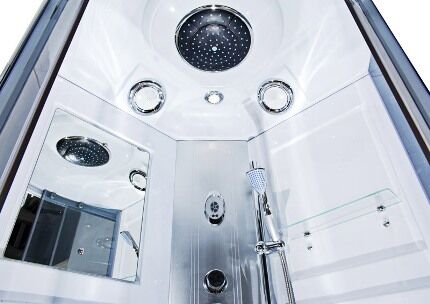
Most models of steam generators for bathrooms and steam rooms are made using a flow-through design. They are always connected to the water supply. In this case, water enters the tank with the heating element through a special valve only as needed, but in automatic mode.
However, there are also portable steam generators. They are not connected to the water supply; water must be poured into them manually before turning them on. They are somewhat more difficult to operate, but such devices can be taken to the dacha.
Selection of household steam generating equipment
It is unlikely that you will be able to take a steam bath with a broom in a shower stall with a steam generator. The steam temperature is not enough to produce the desired effect. It is not for nothing that the equipment in question is usually compared with a traditional Turkish bath, in which the temperature regime is milder than in a Russian one.
It cannot be compared to a Finnish sauna, where the air is dry and the temperature is high. Before you go to choose a steam generator for your shower, you need to clearly understand what will be obtained as a result of its operation. A Russian bathhouse with a broom is completely different.
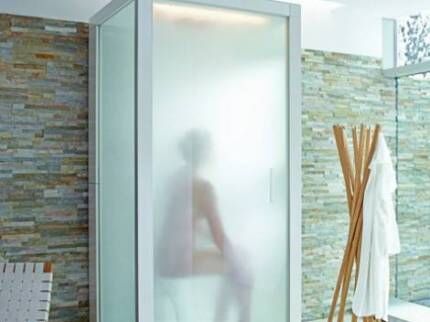
Steam at 45-65°C in the enclosed space of a shower box is a great way to relax. This temperature does not have such an aggressive effect on the human body as in the case of a sauna or Russian bath. But the benefits for humans are approximately the same.
Based on the type of heating element, steam generators are of three types:
- with heating element;
- induction;
- electrode.
They all operate using electricity. In an induction device, water is heated to the state of steam thanks to electromagnetic induction, and in an electrode device, by passing current through special electrodes.
However, household models of steam generators in the vast majority of cases are equipped with a heating element. This is the cheapest equipment for heating water.

There are five main criteria for choosing a steam generator for the bathroom:
- device power;
- outlet steam temperature parameters;
- productivity of the steam generating plant;
- volume of a tank with boiling water;
- Availability of automation and external remote control.
Power household steam generator varies from 1 to 22 kW. Conventionally, about one kilowatt is required per cubic meter of shower stall.But if you plan to install a steam generator to organize a steam room indoors, then 10 kW is quite enough for a room of 13–15 cubic meters.
Only in this case you will have to wait a little longer for the air to warm up. The small space of the shower cabin, limited by walls, heats up much faster.
Steam temperature. Some models are designed for heating at 55 or 60°C - only to these parameters can they heat the air in the shower stall. Structurally, the latter is not airtight; steam from the box still gradually escapes into the bathroom and ventilation.
It is difficult to overheat in such a shower cabin. Moreover, when the temperature inside rises to a certain threshold, the sensor is triggered, as a result of which the generator simply turns off.
Volume of the tank can reach up to 27–30 liters. But such models are bulky and are intended for indoor steam rooms. For a shower stall, it is better to choose a 3-7 liter option. This volume is quite enough for “get-togethers” for an hour, and you don’t need more.
Productivity varies between 2.5–8 kg/hour. The higher it is, the faster the steam will fill the box.
Steam generator control. There are two options - adjustment using buttons on the case or using a remote control. The second option is, of course, more convenient.
To extend the service life of the device in question, it is advisable to choose a steam generator with an overheating sensor and a cleaning system. The first will prevent failure of the heating element, and the second will automatically remove scale from the tank.
But you need to clearly understand that with water oversaturated with lime, no auto-cleaning will help. Only relevant people can help here water filters.
Shower cabins with built-in steam generator
In plumbing stores, steam generators are found separately from shower cabins and as a built-in additional option.
In the first case, steam is supplied inside the box through a separate hose. The second option implies that the nozzles are already installed on the cabin body, and it is only necessary to connect them to the generator with the appropriate tubes.
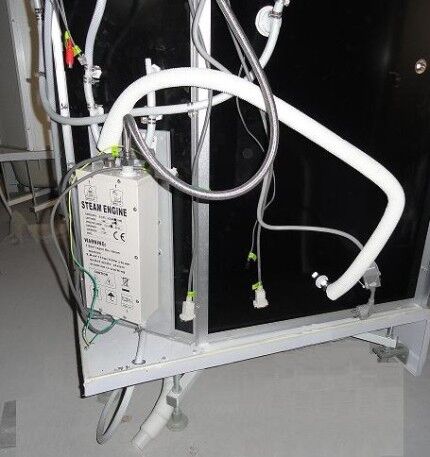
Usually the steam generator comes complete with a lot of other additional functions. These include internal fans, aromatherapy, tropical showers, and “dry heating” (like in a Finnish sauna).
The range of shower cabins is now huge, each manufacturer strives to stand out in the market in some way. But the more of these additions, the more expensive the cabin is for the buyer.
To make the task of choosing a shower box easier, we have prepared a series of articles:
- Shower cabin with sauna: how to choose the right one + review of the best manufacturers
- Typical sizes of shower cabins: standard and non-standard product sizes
- Types of shower cabins: varieties, best manufacturers + tips for choosing
The feasibility of assembling an independent steam generator
Those who want to make a steam generator with their own hands will not have any special problems with assembly. You just need to select a suitable housing and build an electric heating element into it.
Most often, home craftsmen take a small gas cylinder for this. Pipes are inserted into this container to supply water and remove steam, and a heating element is installed inside.
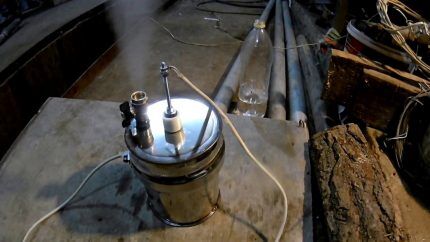
First minus homemade installations for producing steam at home are low efficiency, so it is difficult for them to compete with factory models.
Second minus – safety of use. On the one hand, it is water and electricity, and on the other, steam, which creates pressure. There are possible electric shocks and potential mini-explosions here.
In a multi-storey building, it is highly not recommended to connect such a steam generator to the network. By saving on a factory device, you can then pay with your health and end up with a lot of money that you will have to spend on repairs in your apartment and your neighbors.
Features of installing a steam generator
The shower cabin must be adapted to operate a steam generator. If it does not have a lid on top, then it will need a lot of steam. You will have to heat the entire bathroom, and not a small space in the box. However, some shower cabins do not have such a roof and cannot be operated with a steam generator at all.
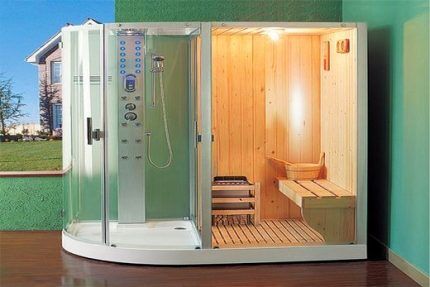
Each shower cabin with a steam generator is equipped with forced internal ventilation. The greatest effect of steam is achieved precisely by convection of air inside. If there is no built-in fan, then you need to take care of installing it in advance. The low-power 12 V version standard for this plumbing is suitable.
Ideally, the device should not be located in a bathroom with a shower, but in an adjacent room. As the humidity in the room increases, the risk of short circuits also increases.The steam generator is an electrical device.
It is best to install it somewhere outside, and install only a steam line in the bathroom to the shower cabin. But this point is often neglected, since there is simply no such room nearby. You have to make an exhaust hood in the bathroom itself so that the humidity in it is not so high.
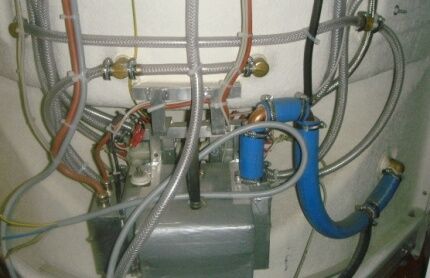
The location for the steam generator should be selected so that it can be easily connected to the water supply, sewerage and electrical networks. The steam pipe is installed with a slope so that the condensate drains and does not linger in it. It is better to tilt towards the shower cabin.
Among steam generators, there are models with a check valve at the outlet, which prevents condensed water from flowing into the device.
Installation of the steam generator is carried out in five steps:
- Mounting the device on the body of the shower cabin or on the wall.
- Connection to water supply and sewerage.
- Connecting a plastic steam line.
- Installation of a temperature sensor in the cabin.
- Connecting the steam generating chamber to the control unit and the power supply network with a three-wire cable with grounding.
It is prohibited to place any wires opposite the steam outlet. If the pipe is torn off by pressure, then there should be no electrical wiring in the path of the hot jet.
After installation is completed, the steam generator should be turned on and wait a few minutes until the first steam appears. Then the device must be turned off immediately.
And literally after a couple of minutes it needs to be activated again. If steam enters the cabin, there are no leaks and it did not work RCD, then everything is done correctly.You can take a shower and steam in a “Turkish bath”.
Steam should enter the shower stall from below. Steam nozzles should not be installed above a person’s head or even above his knees. Don't forget about the possibility of a burn.
In general, installing a steam generator is a simple process. A more or less technically literate person can handle the installation. You just need to separate the water (pipes) and electricity (wires) so that they are as far away from each other as possible.
Conclusions and useful video on the topic
When choosing a steam generator, first of all you need to focus on the dimensions and power of the device. But there are several other nuances. The presented videos will allow you to quickly understand all the functions and characteristics of the steam generator, as well as how it should be installed.
Review of a shower cabin with a built-in steam generator:
Possible malfunctions in the operation of the steam generator:
Even a novice master can install a steam generator in a shower stall. You need to connect a pair of pipes (sewage + cold water) and a steam line to the device, and then plug it into a 220 V outlet. The only important thing here is to prevent the electrical wiring from crossing a hot tank or pipeline.
Do you have anything to add, or do you have questions about choosing and installing a steam generator for a shower? You can leave comments on the publication, participate in discussions and share your own experience of using such equipment. The contact form is located in the lower block.




We have such a device at home. Of course, it cannot replace a sauna and SPA, but it provides excellent relaxation to a much greater extent than just a shower.I like to pour orange essential oil into the water in the tank - the effect is simply magical, as if I was in a fairy tale. The only thing that must be done after using the steam generator is to ventilate the bathroom thoroughly, because... otherwise, everything that can possibly be damp will become damp there. When the bathroom cools down, a lot of condensation forms on the walls.
I would like a shower stall like this with a steam generator, you are still teasing with oils. But I’m afraid that this might turn out to be an indulgence that will get boring in a couple of months.
And the question immediately arose - is it possible to make the steam go into the hood, and not into the bathroom?
It is not only possible, but also very desirable to provide normal ventilation. The humidity from the steam is high and if you do not remove it, mold will quickly grow in the bathroom. If it is not possible to remove steam directly, then it is worth making a forced system.
You think correctly, but here it is necessary to clarify that such a shower stall requires a very good forced exhaust system. I would advise choosing a model with several operating modes.
For example, if you decide to just take a shower or wash your hair, then there is no point in turning on the hood at maximum performance. This is impractical and will be quite expensive if you use a hood without power control. Also pay attention to the noise level, choose a hood with the lowest value for the noise level produced.
If you search on the website, there are materials that provide detailed instructions for selection and installation forced ventilation for baths and toilets. In particular, I can recommend paying attention to the Soler&Palau Silent-100 exhaust fan. I think that its performance should be enough for your bathroom with a steam generator in the shower.